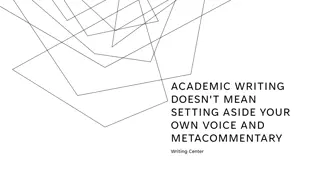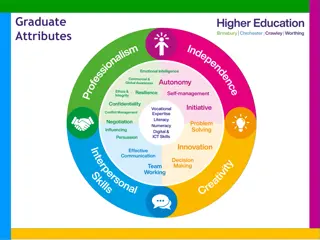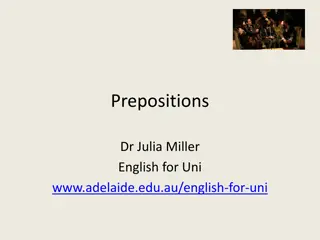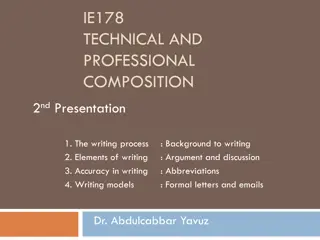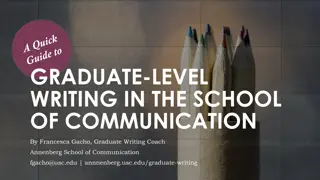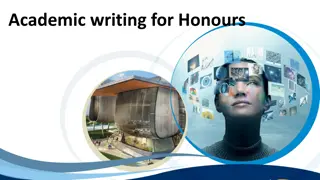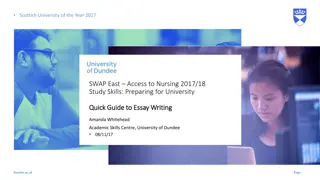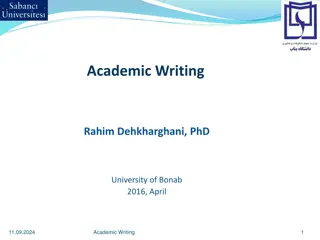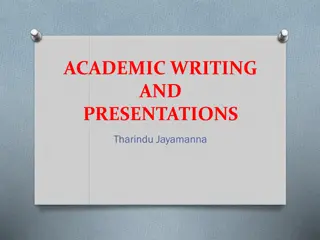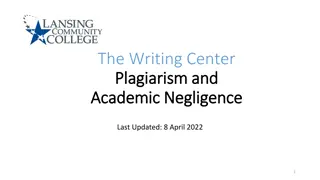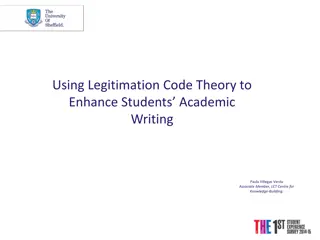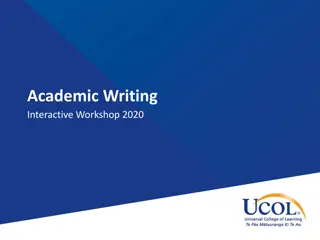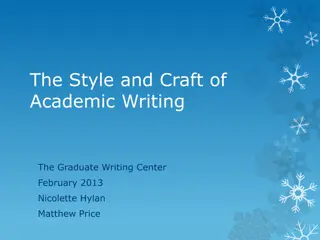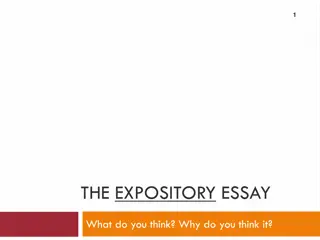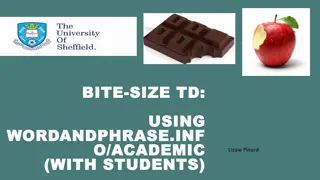Understanding the Academic Writing Process
Explore the stages involved in academic writing, from analyzing the title to proofreading the final draft. Learn about the basics of writing, types of academic writing, common reasons for writing, and text components like paragraphs and citations.
Download Presentation

Please find below an Image/Link to download the presentation.
The content on the website is provided AS IS for your information and personal use only. It may not be sold, licensed, or shared on other websites without obtaining consent from the author. Download presentation by click this link. If you encounter any issues during the download, it is possible that the publisher has removed the file from their server.
E N D
Presentation Transcript
The Writing Process Explaining all the stages of producing a piece of academic writing, from analysing the title, reading the sources, note-making and referencing, through to rewriting and proofreading the final draft. 2
1.1 Basics of Writing (p.3) WHY DO WE WRITE? WHAT IS THE PURPOSE OF ACADEMIC WRITING? CAN YOU THINK OF FOUR REASONS? 3
To report research done by the writer Common reasons for writing (p.3) To answer a question the writer was given To give the writer s views on a topic To synthesise research done by others 4
Types of academic writing (p.4) What are the differences between these common types of academic writing? Essay Dissertation/ Thesis Project Article Notes Report 5
The format of writing tasks (p.4) Longer essays and reports usually include: Introduction Main body Literature review Case study Discussion Conclusion References Appendices 6
Read the short text and identify a), b), c), d) and e) The a) A Fishy Story b) Misleading health claims regarding omega-3 fatty acids components of academic writing (p.7) c) Introduction d) There has been considerable discussion recently about the benefits of omega-3 fatty acids in the diet. e) It is claimed that these reduce the risk of cardiovascular disease and may even combat obesity. 7
Text components (p.7) a) title b) sub-title c) heading d) sentence e) phrase What s the function of these other components? paragraph citation abbreviation italics brackets 8
Discuss these questions with another student: What is a paragraph? Writing in paragraphs (p.8) Why are texts divided into paragraphs? How long are paragraphs? Do paragraphs have a standard structure? 9
1.2 Reading: Finding Suitable Sources (p.10) What types of text may be suitable for academic work? 10
Types of text (p.13) What are the advantages and disadvantages of these text types for academic writing? Textbook Website Journal article Official report Newspaper or magazine article E-book Edited book 11
Online library catalogues let you find the material you need quickly. Using library catalogues (p.14) Remember: Vary your search terms for best results Use the most up-to-date books Subject databases help you find relevant journal articles 12
1.3 Reading: Developing Critical Approaches (p.16) READING ACADEMIC TEXTS IS NOT LIKE READING A NOVEL! WHAT IS THE BEST METHOD OF READING TEXTS? 13
Choosing suitable texts (p.18) 1. Read title and sub-title carefully 2. Survey text features e.g. abstract, contents, index 3. Skim text for gist is it relevant? 4. Scan text for information you need e.g. names 5. Read extensively when useful sections are found 6. Read intensively to make notes on key points 14
Fact and opinion (p.20) As you read you must distinguish between facts: Singapore lies near the equator. and opinions: Singapore is a lively, welcoming city. You must also decide if the facts are true: Singapore has a hot, dry climate (?). 15
Fact or opinion? (p.20) Decide if the following contain facts, opinions or both. Are the facts true? 1 Sydney is the capital of Australia. 2 Australia is a dynamic, prosperous country. 3 The majority of Australians live on sheep farms. 4 Australia is the largest island in the world. 5 Australians are the world s best cricket players. 16
As you read you should ask yourself the following questions: Critical thinking (p.23) What are the key ideas in this? Does the argument develop logically? Are the examples given helpful? Does the author have any bias? Does the evidence presented seem reliable? 17
What do we mean by plagiarism? 1.4 Avoiding plagiarism (p.26) Why should it be avoided? 18
To show that you are using someone else s ideas, you can use either: 1 Summary and citation: Smith (2009) claims that the modern state Acknowledging sources (p.27) 2 Quotation and citation: According to Smith: The point is not that the state (Smith, 2009: 103) 19
Acknowledging sources (p.27) These in-text citations are linked to a list of references at the end of the article or chapter: Author Smith, M. (2009) Power and Macmillan Date Title Place Basingstoke: Palgrave Publisher the State This reference gives readers the information they need to find the source if they want to study the original. 20
These are some of the key words used in essay titles. What are they asking you to do? 1.5 From understanding essay titles to planning (p.33) Analyse Assess Describe Discuss Examine Illustrate Outline Summarise 21
All written work needs planning, even in exams. Writing outlines (p.37) A clear plan helps answer the question fully. Different patterns of outline suit different students what is your favourite? 22
Two outline styles (p.37) Title: What are the most significant sources of renewable energy? List a) Wind best sites often remote b) Solar costs have reduced sharply c) Thermal limited application Mind map Wind (best sites often remote) Sources Thermal (limited application) Solar (costs have reduced sharply) 23
1.6 Before note-making you must find the most important and relevant ideas in a text. Finding key points and note- making (p.39) Where are these often found? 24
You will develop your own style of note-making. How many notes you make depends on the task. Effective note- making (p.44) Always use your own words don t copy Record the source of your notes Keep notes simple no articles or prepositions Don t crowd notes and use clear headings Use symbols (=, +, >) Abbreviations save space (e.g. govt. dept.) Can you suggest any other tips? 25
What makes a good summary? 1.7 Tell another student about a film you have recently watched. Summarising and paraphrasing (p.46) Did they summarise the story clearly? Why? / Why not? 26
Stages of summarising (p.47) In academic work summarising can be a one- sentence outline or include much more detail. Put these steps of summarising in logical order: Write summary from notes Make notes of key points Read original text carefully Underline or highlight key points Check summary to ensure accuracy 27
Paraphrasing (p.51) While summarising aims to reduce text length, paraphrasing attempts to restate the ideas. Effective paraphrasing is vital for avoiding plagiarism. It should: Have a different structure to the original Have mainly different vocabulary Retain the same meaning 28
1.8 References and quotations (p.54) Why should we use references and citations? To show awareness of the relevant sources To allow your readers to find the sources To avoid plagiarism Can you suggest any situation where it is NOT necessary to use references and citations? 29
Citations and references (56) Citations provide a link to the list of references at the end of your paper: For a quotation: Family name/ date of publication/ page no. (Smith, 2009:37) For a summary: Family name/ date of publication Smith (2009) 30
Using quotations (57) Why use quotations in written work? When the original words are distinctive When the original is concise When the original is well-known Quotations should be introduced by a suitable phrase: As Keynes (1923) remarked In the long run we are all dead . 31
At the beginning of a paper writers generally refer to the views of other writers on the topic. 1.9 Combining sources (p.64) Discuss reasons for this with another student. 32
Referring to sources (p.64) In longer papers these sections may be called Literature review . Read the following extract: The expectations which students have of higher education are influenced by their prior educational experiences (Ramsden, 1992, p.82; Tinto, 2005; Cook and Rushton, 2008). What is the writer s reason for giving these sources? 33
It is important to compare a range of views to show that you are familiar with the different or conflicting views on a topic. Taking a critical approach (p.65) Discuss possible reasons for this with another student. 34
Discuss the following with another student: Why do we write in paragraphs? 1.10 Organising paragraphs (p.71) How do paragraphs help the reader? Do all paragraphs have the same format? 35
A paragraph is a group of sentences on the same topic. Most paragraphs contain at least four sentences. Paragraph structure (p.72) The parts of a paragraph are linked together by reference words, conjunctions and adverbs. Usually the first sentence introduces the topic. 36
To introduce a new topic: Turning to the issue of inflation Inflation is another area to consider Introducing and linking paragraphs (p.74) Adverbs can also be used: Traditionally, few examples were found Currently, there is little evidence of Originally, most families were 37
Introductions are a critical component of any paper. 1.11 Introductions and conclusions (p.76) Suggest possible reasons for this. Discuss what you expect to find in an introduction. 38
Introduction structure (p.77) This is a common outline of an introduction: Definition of any key terms Relevant background information Review of work by other writers Aim of the paper Your research methods Any limitations to your research An outline of the paper 39
Conclusions (p.81) Arrange these parts of a conclusion in a logical sequence: Suggestions for further research Summary of your main findings The implications of your work Reference to the limitations you set Link back to original question to show it has been answered 40
The first draft of written work can always be improved. When you re-read, ask these questions: 1.12 Rewriting and proofreading (p.83) Does this fully answer the question? Is it well-balanced between the sections? Does the argument develop logically? Have I forgotten any critical points? Is it the right length, not too short or long? 41
Proofreading (p.84) Proofreading is the final stage of the writing process. Even minor errors can create difficulty for the reader: Multiple errors will make a sentence almost incomprehensible: Tow factors need to be considered A america senate once say: truth is frist casualty off war . 42



